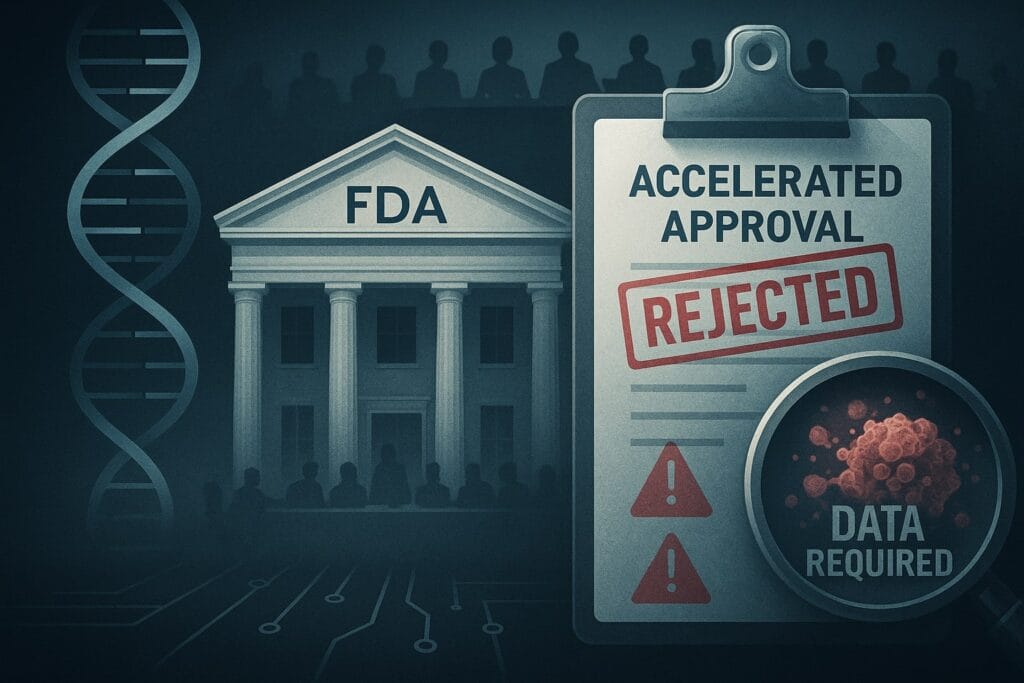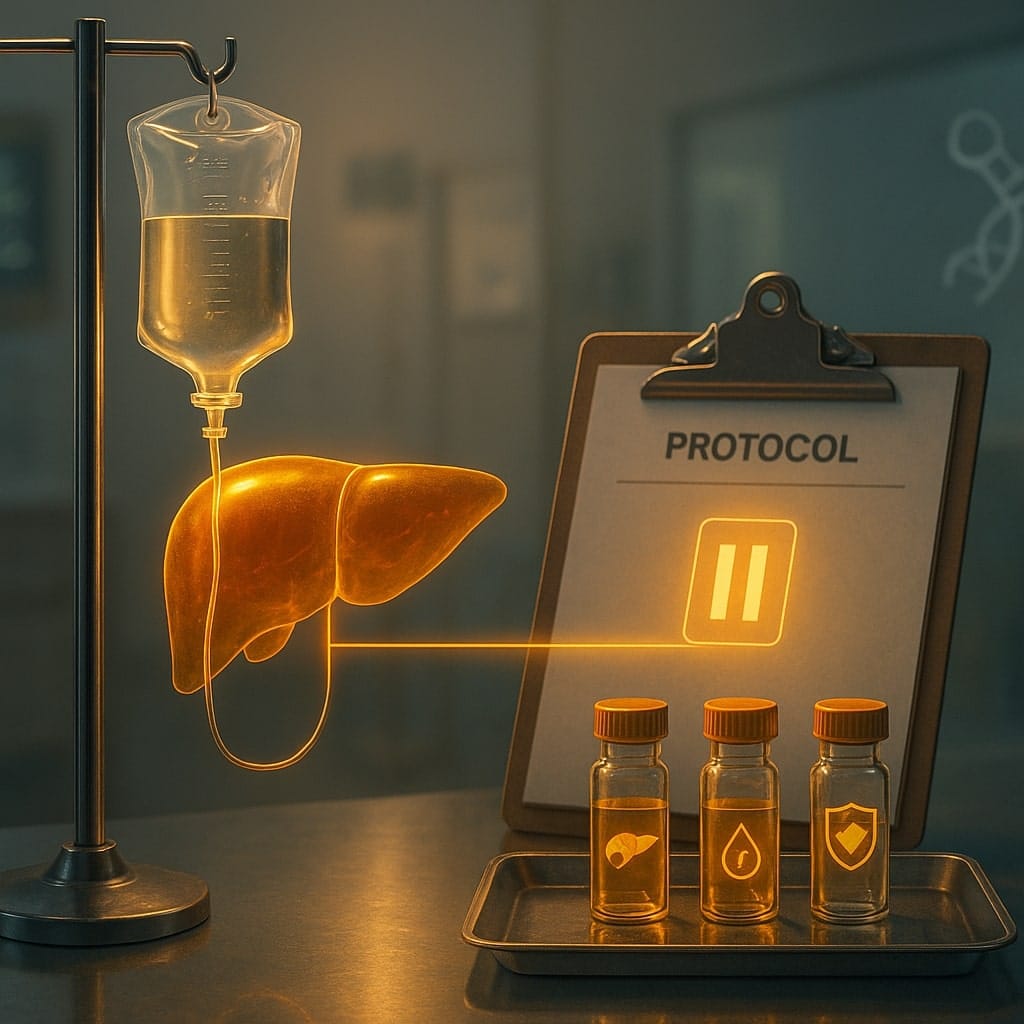When Dr. Vinay Prasad was abruptly removed from his FDA post earlier this summer, many in the biotech industry breathed a sigh of relief. Prasad had a reputation as a stringent critic of lax drug approvals and had begun pressing pause on a high-profile gene therapy amid safety concerns. But now, less than two weeks later, he’s back – reinstated as head of the FDA’s Center for Biologics Evaluation and Research (CBER) at the request of the agency. This whiplash reversal has industry observers parsing what it means for the future of oncology drug reviews, gene therapy oversight, and the FDA’s evidentiary standards. The short answer: Prasad’s return likely heralds a more rigorous, data-driven approach, even if it ruffles political feathers. His well-documented policy positions – skepticism toward accelerated approvals based on slim data, insistence on hard endpoints in trials, and caution about relying on real-world evidence – will shape FDA advisory committees’ deliberations and could recalibrate biotech investors’ expectations of a smooth ride to market.
Table of Contents
ToggleA Philosophy of Evidence Over Expediency
Prasad’s appointment earlier this year was seen as a philosophical course correction for the FDA, and his reinstatement doubles down on that direction. A hematologist-oncologist and prolific researcher, Prasad has built a career calling out what he views as weak evidence in drug approvals. He has lambasted the accelerated approval pathway for making it “too easy” to get drugs on the market without proven clinical benefit. In his academic work, he repeatedly pointed out instances where cancer drugs approved on surrogate endpoints – like tumor shrinkage or progression-free survival – failed to show improvements in overall survival or quality of life later on. Now, back at the FDA helm for biologics and by extension cell and gene therapies, Prasad is positioned to act on those convictions from inside the agency.
We can expect a tougher line on trial endpoints for new oncology drugs. Under Prasad’s influence, FDA advisory committees reviewing cancer therapies may place greater weight on robust outcomes (survival, functional improvements) rather than surrogate lab markers. He has publicly supported requiring randomized controlled trials with “hard clinical outcomes” even for cutting-edge treatments. This is a notable shift from the previous FDA leadership, which had grown more flexible – especially for rare diseases or unmet needs – often accepting surrogate endpoints or smaller single-arm studies. Prasad’s stance doesn’t mean the FDA will never use surrogates, but it does mean companies will need stronger justifications and perhaps more confirmatory data at hand. As an example, he was openly critical of a recent approval of a gene therapy for muscular dystrophy (Sarepta’s Elevidys) that lacked clear evidence of efficacy. Insiders say that during his brief initial tenure, he sided with FDA scientists who questioned that approval, in contrast to the more permissive approach of his predecessors.

His philosophy is perhaps best summarized as “evidence over hope.” Prasad and like-minded colleagues argue that approving drugs on thin evidence does patients a disservice, offering false hope and exposing them to potential harm and cost without clear benefit. Now, as the de facto chief of vaccines, gene therapies, and related biologics, he can enforce higher evidentiary standards. This likely means more demanding data requirements for accelerated approval in oncology – e.g. requiring that ongoing confirmatory trials be well underway (or completed) at the time of accelerated approval, and willing to pull drugs off the market if those trials fail to confirm a benefit. Under previous leadership, some drugs lingered for years on the market without verified clinical benefit. Prasad has signaled that era should end. In fact, his very presence has some in pharma worried that “approval has become too lax” and that he will make it harder for drugs with modest data to slip through.
Gene Therapies Under Heightened Scrutiny
Perhaps no area will see the impact of Prasad’s return more than gene therapies. Consider the context: just before his departure, Prasad was embroiled in a controversy over a gene therapy for Duchenne muscular dystrophy. Two patients had died after receiving the newly approved treatment, and a third death in a trial prompted Prasad’s FDA to halt distribution of the therapy in July pending safety review. That decision drew fire from political allies of the administration who accused him of undermining the program, and indeed it appears to have contributed to his short-lived ouster. The FDA reversed the pause days after his exit, resuming shipments of the drug. Now that he’s back, one can infer the FDA will put patient safety first, even at the expense of speed, for high-risk therapies. Under Prasad’s watch, accelerated approvals for gene therapies might be harder to come by unless the data are truly compelling or the condition is dire and untreatable.
We’re likely to see more rigorous demands for long-term follow-up data in gene therapy trials and possibly smaller initial target populations for approvals until safety is proven. Prasad’s team could, for example, require that certain gene therapies be approved only for the sickest subgroups initially, with broader use contingent on further evidence. This conservative rollout approach manages risk – exactly the kind of risk management he championed when he halted that DMD therapy after the fatalities. He will also be keen to empower FDA’s scientific staff and advisory committees to voice concerns. Recall that in the Elevidys case, FDA’s own reviewers and an advisory committee had reservations about approving it without more evidence, but the previous CBER director overrode those concerns. Prasad’s return sends a message that such overrides are less likely now. The internal culture may shift to one where if the experts in the room aren’t convinced of a therapy’s safety or efficacy, the FDA leadership won’t bulldoze through an approval for the sake of expediency.
For biotech companies developing gene therapies, this means the bar for proof of concept and safety signals is higher. It might translate to longer trials or additional studies before submission. Some gene therapy makers that hoped for quick approvals based on Phase 1/2 data might need contingency plans for conducting Phase 3 trials after all. Investor expectations are adjusting accordingly – we already saw an immediate reaction back in May when Prasad’s initial appointment was announced: biotech stocks, particularly those in cell/gene therapy, tumbled on the news. The reasoning was clear: a harder FDA means longer paths to revenue and more uncertainty. Now that he is confirmed to stay in charge, gene therapy firms will likely face tougher questions from investors about their regulatory strategy. Are their clinical endpoints meaningful enough? Do they have robust safety monitoring in place? How will they satisfy a FDA director who openly worries about rushing out novel treatments without ample data?
One concrete implication is that real-world evidence (RWE) will be viewed with a more critical eye in gene therapy post-marketing commitments. The FDA in recent years explored using RWE – such as observational studies or patient registries – to supplement clinical trials for gene therapies in rare diseases. Prasad’s general view is that observational data are not a substitute for randomized trials when it comes to demonstrating efficacy. He co-authored commentary in the past questioning whether real-world studies can truly guide treatment recommendations in oncology. So, while RWE will still have a role (for example, in tracking long-term safety or perhaps for refining patient selection), companies should not expect RWE alone to convince this FDA to expand an indication or fulfill a required confirmatory study. Under Prasad, confirmatory trials will need to be scientifically rigorous – and if they fail, he appears unafraid to yank approvals. This aligns with his public criticism that the FDA has sometimes been too slow to withdraw drugs that don’t pan out, allowing companies to profit in the interim while patients potentially gain nothing.
Shaping Advisory Committees and Standards of Evidence
Another area of impact is the FDA’s advisory committee process. These committees of outside experts vote on whether the FDA should approve a drug, and their recommendations, while not binding, carry weight. Under more permissive regimes, we’ve seen instances where committees vote “no” due to weak evidence, but the FDA approves the drug anyway. Prasad’s FDA is less likely to override negative committee votes. In fact, we may see the composition of committees tilt toward members who share a rigorous evidentiary philosophy. The agency has some discretion in selecting or emphasizing certain voices. Given Prasad’s alignment with scientists who demand strong data, it’s plausible that upcoming advisory panels on cancer drugs or gene therapies will include statisticians or clinical trialists who ask tough questions about study design and endpoints.
Already, industry observers noted that Prasad’s arrival was “a triumph for evidence over hope” among FDA critics who wanted stricter standards. Figures like Reshma Ramachandran at Yale applauded his history of research exposing problems with surrogate endpoints. We can expect those perspectives to be influential in the FDA’s deliberations. This might manifest in advisory committees being more probing: for instance, asking whether a given improvement in a lab value truly correlates with patient benefit, or whether a single-arm trial might be subject to bias. If a company comes in front of a committee with marginal data, the chances of a negative or split vote are higher now. And unlike in some past cases, a negative vote will likely mean a delayed or rejected approval rather than being waved through.
From the trial design perspective, drug developers may need to preempt these concerns by selecting endpoints that directly measure how a patient feels, functions or survives. In oncology, that could mean prioritizing overall survival or patient-reported outcomes in trials instead of relying solely on tumor imaging results. For neurological gene therapies, it could mean demonstrating functional improvements, not just a biomarker change. One could argue this ultimately benefits patients and payers – drugs that clear this higher bar are more likely to deliver real benefits and justify their costs. But for biotech firms, it’s a more challenging hurdle and could slow down development timelines.
Biotech Investors Adjust to the New Normal
The reaction of biotech investors to Prasad’s FDA reflects the stakes. When news of his appointment first broke, some investors panicked, selling off shares especially in smaller cap biotech reliant on regulatory momentum. A William Blair analyst note at the time tried to calm nerves by pointing out that many oncology drugs (those regulated by the FDA’s drug center, CDER) might not be directly under Prasad’s purview. However, that distinction offers only partial comfort. Many cutting-edge therapies – cell therapies, gene therapies, cancer vaccines – do fall under CBER, Prasad’s domain. Moreover, even for traditional drugs, the tone set at the top can influence the whole agency’s culture. Now that he is firmly in place, biotech firms and their backers are recalibrating risk models. Expect due diligence on early-stage companies to ask more pointedly: “Will the FDA actually approve this in the current climate?” Drugs that might have sailed through under a more lenient approach could now face requests for additional trials, which means additional expense and dilution for companies.
On the flip side, companies with truly transformative data – say a gene therapy showing unequivocal life-saving potential, or a cancer drug with clear survival benefit in a robust trial – have little to fear. In fact, a stricter FDA could advantage those players by weeding out marginal competitors. If Prasad’s tenure leads to a purge of ineffective drugs and a slowdown in approvals of “me-too” products with minor benefits, it could boost the prospects of genuinely innovative treatments. This winnowing might shift investment toward technologies likely to meet the higher bar (for example, platform technologies that can demonstrate clear superiority over standards of care). Some venture capitalists even welcome the change, viewing it as a correction to over-exuberance. As one biotech CEO noted, the industry’s negative gut reaction comes from “traditional bio” getting comfortable with a lax system, whereas principled regulators like Prasad are seen as “chaos agents” precisely because they “can’t be controlled” by industry pressure. But disciplined capital might favor that approach in the long run, focusing on quality over quantity of approvals.
In practical terms, investors may start favoring companies that build in more regulatory resilience. That could mean developing backup trial plans, diversifying portfolios across therapeutic areas (since Prasad’s influence is strongest in the CBER realm initially), or investing in support services like trial data quality and pharmacovigilance which will be in demand. There is also likely to be an impact on real-world evidence ventures and post-market studies. If the FDA under Prasad is less willing to count post-market observational studies as fulfillment of requirements, companies that specialize in RWE generation might need to reposition their offerings as complementary rather than an alternative to trials.
One sector that could be indirectly affected is the burgeoning field of accelerated programs for ultra-rare diseases. FDA Commissioner (and Prasad’s boss) Dr. Marty Makary has floated ideas like a “plausible mechanism” approval pathway for ultra-rare conditions – essentially allowing approval if a drug’s mechanism makes sense biologically even with scant clinical data. It’s unclear how Prasad’s philosophy will align with that. Tension may exist between an agency head eager to foster innovation for rare diseases and a center director concerned about evidentiary standards. If Makary’s approach prevails in some cases, Prasad’s presence ensures there will still be strong internal debate and likely stringent guardrails on any such pathway. From the investor standpoint, firms developing therapies for rare diseases might experience a bit of whiplash: encouragement from top leadership but meticulous scrutiny from Prasad’s shop. Ultimately, the consensus is that standards are tightening – one advocacy group even noted that his appointment “may signal a major shift in data required to approve products, particularly cell and gene therapies”.
A New Chapter for FDA: Balancing Innovation and Integrity
The broader implication of Vinay Prasad’s reinstatement is a rebalancing of the FDA’s mandate between speed and safety/effectiveness. In recent years, under political and public pressure, the pendulum had swung toward speed – manifest in record numbers of approvals, many expedited. Prasad’s influence is swinging it back toward stringent validation. It’s a reminder that the FDA’s stance is not static but responsive to leadership’s values and the administration in power. Notably, the current administration has been keen on shaking up health agencies, and Prasad’s return came even under political fire, indicating a complex interplay of pressure and principle. His ability to retain the role may depend on delivering what he promises: upholding high standards without completely stifling innovation.
For patients and clinicians, this new chapter could restore some confidence that new drugs truly merit their approvals. We may see fewer headline-grabbing approvals that later disappoint, and more drugs that, once approved, have solid evidence behind them. Advisory committee members, many of whom are physicians, might also appreciate an environment where their votes and concerns carry real weight in final decisions. On the other hand, patients with life-threatening illnesses might worry that a stricter FDA could deny or delay access to a therapy that might help. This is the classic tension: how to allow hope and innovation while guarding against hype and harm. Prasad’s public statements suggest he believes in not giving “false hope” via unproven treatments, arguing that it’s better in the long run to only approve what works. It’s a defensible position, but one that will continue to be debated in the court of public opinion, especially for dire conditions.
In the coming months, watch for key test cases of this philosophy. An upcoming advisory meeting on a cancer immunotherapy, or a pending decision on a high-profile gene therapy, will speak volumes about how Prasad’s FDA will act. If the agency surprises by rejecting a drug many thought would be greenlit, that will confirm the new normal. Conversely, if approvals continue at a similar clip but with more stringent labeling and requirements, it may indicate a nuanced approach that still values innovation but with more checks. Regardless, biotech companies and investors would do well to adapt proactively. The FDA’s trust principles – safety, efficacy, quality – are being reasserted with vigor, and aligning with them is the clearest path to success under this regime. In a sense, the FDA is undergoing its own evidence-based reboot, and all stakeholders will be adjusting to the recalibrated rhythm of regulation.












